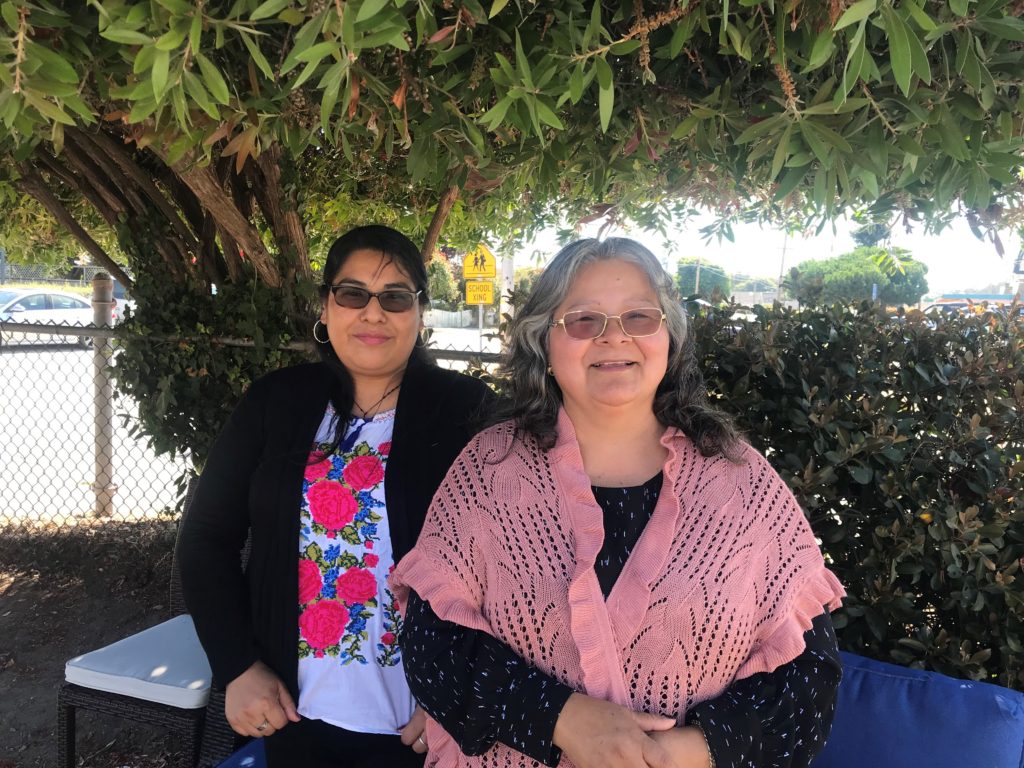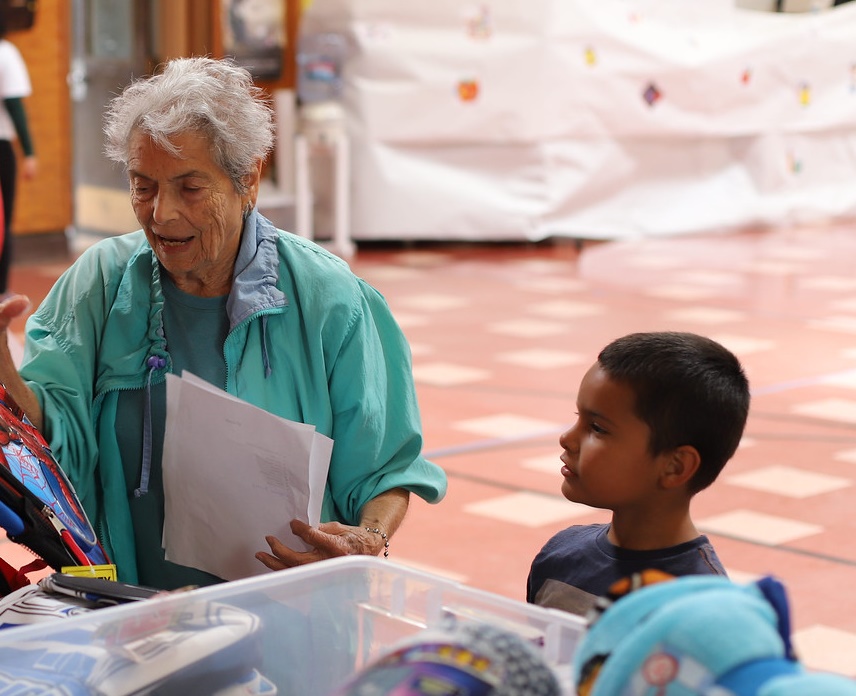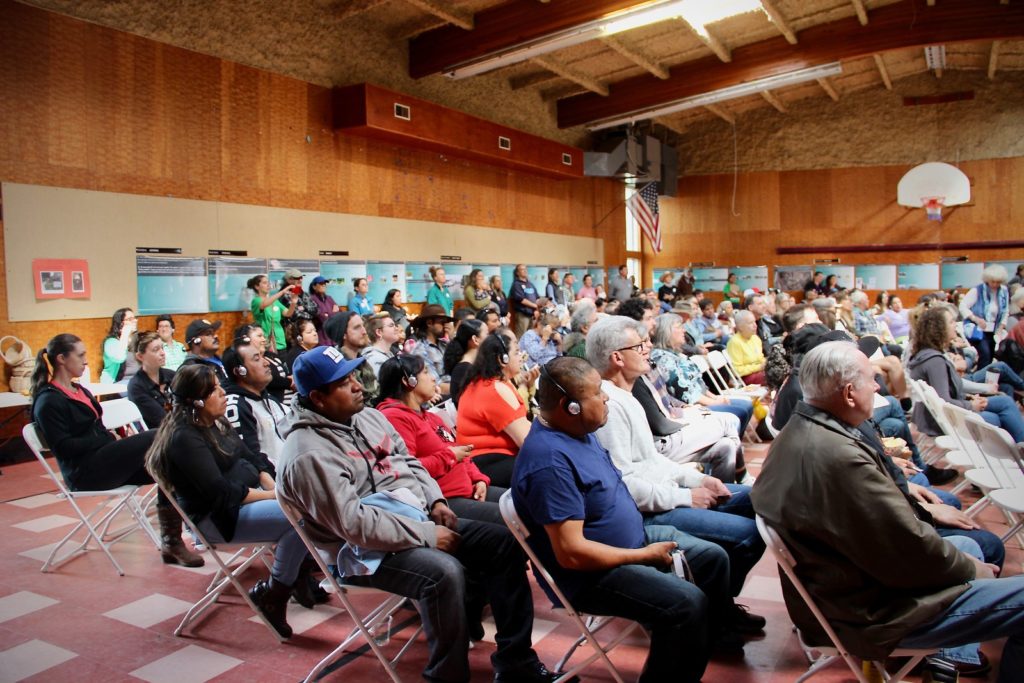
In the decades before they became ‘Promotoras de Salud’ (community health workers) with Puente, Yolanda Morales and Yesenia Ramirez worked in many Pescadero fields and flower nurseries. Some of their working conditions were illegal, although they didn’t know it at the time.
Morales remembers being exposed to toxic pesticides, which made her and her colleagues sick sometimes. They were never given protection on the job.
“Right after the plants got sprayed, we’d have to harvest them with our bare hands. Our hands would get bumps on them. And I was seven months pregnant,” she says. “We didn’t know we had basic rights as farm workers. We were scared and we did anything they told us.”
Conditions like these still prevail at some farms on the San Mateo County coast and throughout California, where farm workers are regularly exposed to pesticides while they are working.
Today, Morales and Ramirez are extremely knowledgeable about the legal rights of farm workers. Their current mission is to inform and educate the rest of the community.
“So, like now, I know that I could have said to the supervisor, ‘I’m not going in there,’ says Morales.
The women owe their newfound knowledge to an online diploma program in occupational health. The program is offered through the Berkeley-based Health Initiative of the Americas, in conjunction with The Universidad Autónoma de Zacatecas, a Mexican public research university. The four-month interactive course is designed for Spanish-speaking health promoters. Morales and Ramirez started the course in May, and they are close to completing it.
“We’re excited to have something that’s built for the health promoters in Spanish, geared toward occupational health. It was the perfect formula for us,” says Tricia O’Hara, Puente’s Community Health Manager who until very recently was overseeing the Promotoras program.
The training is the first of its kind. It will benefit local farm workers by keeping them safe at work, and it also builds the computer skills and confidence of Puente’s two Spanish-speaking health promoters.
Each module takes many hours to complete, and is chock-full of videos, reading materials, quizzes and questionnaires. Learners complete a small summary essay at the end of each module, and participate in online chat boards with adults in other locations, says O’Hara.
“There’s a community of health promoters throughout the Americas that are taking this online course, and Yolanda and Yesenia are able to connect with them. It’s a really phenomenal opportunity.”
Puente founded its Promotoras project four years ago with the goal of training three community members to talk to people about their health and connect them with Puente services when needed. Today, the women visit local farms and ranches three days a week.
Over the years, the Promotoras have received some training on topics like blood pressure, healthy lifestyle, and mental health – with the aim of passing that knowledge on to the community. The women have even found creative ways to do that, by conducting five-minute mini-seminars for workers during work breaks in the fields.
Occupational health is by far the most specialized and widely-applicable training they’ve received, and it will go a long way towards keeping farm workers safe on the job.
When the Promotoras visit people, “we talk about what migrants and their families face when they come here from a different country. The dangers they’re exposed to, as well as things they might not know – dangers in the workplace to they may not be aware of,” says Morales.
These dangers can include working with pesticides without receiving proper training from a supervisor, or tipping over on a tractor for the same reasons, and incurring serious injuries.
There are also mental and emotional hurdles to working as a migrant farmworker in a new country. “Some people will say they’re going to go to the U.S. for two years, and time passes and they’ve been here much longer than they wanted. There’s an impact on them, and on their families that they left behind.”
It’s a state of limbo, and the uncertainty does take a toll, she says.
“We can go and talk to these people, refer them to Puente’s Behavioural Team. If they feel frustrated, or they need to talk to someone, there are people who can help them, who can talk to them and advise them.”
Whether documented or undocumented, there is a unique vulnerability to working as farm laborer that increases with the language barrier, as well as with the uneven power dynamics between employer and employee.
The health promoters have witnessed how those dynamics can create fear and reluctance to speak up when there’s a problem, just as Morales experienced when she was a field worker.
“They’re afraid to report things. They’re worried about their housing. [Housing is often tied to employment in Pescadero, where employees pay rent to their employers.] We’re here to talk to them and to tell them we’re here for them, and that if they report things, nothing bad will happen to them. We tell them that undocumented migrant workers also have their rights here,” Morales says.
Even something that seems clear-cut, like getting treated for injuries on the job, can be fraught. Workers may not disclose the injury to a supervisor. And the supervisor may not take them to the hospital. In one recent module, Morales and Ramirez learned about what workers’ rights dictate (a trip to the hospital for anything that exceeds a basic Band-Aid situation).
Having health promoters who not only live in the community they serve, but also share similar life experiences, makes them twice as effective on the job, says O’Hara. It also builds their self-esteem.
“There have been times where Yolanda and Yesenia say, ‘Oh yeah, I’ve seen this before and I know what they’re talking about.’ So being reaffirmed in their own experiences is very beneficial.”
The women were excited to be taking a college-level course offered by a Mexican university whose name they recognized. Some modules required that they spend up to six hours in front of the computer, reading, writing and interacting with the material. They have been up for the challenge.
“It’s a lot of new information, but also stuff they intuitively know from growing up in this area and working in the fields themselves – so that’s been a really good balance,” adds O’Hara.
The Promotoras have worked hard to gain the trust of the people they serve. Morales and Ramirez have long personal histories of helping the people around them, including strangers, and they are passionate about how knowledge and information can help people have a better life.
“We work to give them confidence and to believe in us. That’s our role. We tell them that they’re not alone and we’re here to help them,” Morales says.
If you would like to support more programs to support health and wellness click here.
Nuevo curso en línea ayuda a las promotoras de Puente a mantener seguros a los trabajadores agrícolas en el trabajo
En las décadas anteriores, se convirtieron en “Promotoras de Salud” (trabajadoras comunitarias de salud) con Puente, Yolanda Morales y Yesenia Ramírez que trabajaron en muchos campos de Pescadero y viveros de flores. Algunas de sus condiciones de trabajo eran ilegales, aunque no lo sabían en ese momento.
Morales recuerda haber estado expuesto a pesticidas tóxicos, y que nunca se les dio entrenamiento apropiado y protección en el trabajo.
“Justo después de rociar las plantas, tendríamos que cosecharlas con nuestras propias manos. Nuestras manos se toparon con esos químicos. Y tenía siete meses de embarazo,” dice ella. “No sabíamos que teníamos derechos básicos como trabajadores agrícolas. Estábamos asustados e hicimos todo lo que nos decían.”
Condiciones como estas aún prevalecen en algunas granjas en la costa del condado de San Mateo y en todo California, donde los trabajadores agrícolas están expuestos regularmente a pesticidas mientras trabajan.
Hoy, Morales y Ramírez están extremadamente informadas sobre los derechos legales de los trabajadores agrícolas. Su misión actual es informar y educar al resto de la comunidad.
“Entonces, como ahora, sé que podría haberle dicho al supervisor:” No voy a entrar allí,” dice Morales
Las mujeres deben su nuevo conocimiento a un programa de diploma en línea en salud ocupacional. El programa se ofrece a través de la Iniciativa de Salud de las Américas con sede en Berkeley, en conjunto con la Universidad Autónoma de Zacatecas, una universidad mexicana de investigación pública. El curso interactivo de cuatro meses está diseñado para promotores de salud de habla hispana. Morales y Ramírez comenzaron el curso en mayo, y están cerca de completarlo.
“Estamos entusiasmadas de tener algo creado para los promotores de salud en español, orientado a la salud laboral. Fue la fórmula perfecta para nosotros,” dice Tricia O’Hara, Gerente de Salud Comunitaria de Puente que empezó recientemente a supervisar el programa Promotoras.
El entrenamiento es el primero de su tipo. Beneficiará a los trabajadores agrícolas locales al mantenerlos seguros en el trabajo, y también desarrolla las habilidades informáticas y la confianza de los dos promotoras de salud de habla hispana de Puente.
Cada módulo tarda muchas horas en completarse y está repleto de videos, materiales de lectura, y cuestionarios. Los alumnos completan un pequeño ensayo resumido al final de cada módulo y participan en tableros de chat en línea con adultos en otros lugares, dice O’Hara.
“Hay una comunidad de promotoras de salud en todo el continente americano que está tomando este curso en línea, y Yolanda y Yesenia pueden conectarse con ellos. Es una oportunidad realmente fenomenal.”
Puente fundó su proyecto Promotoras hace cuatro años con el objetivo de capacitar a tres miembros de la comunidad para hablar con las personas sobre su salud y conectarlos con los servicios de Puente cuando sea necesario. Hoy, las mujeres visitan granjas y ranchos locales tres días a la semana.
A lo largo de los años, las Promotoras han recibido capacitación sobre temas como presión arterial, estilo de vida saludable y salud mental, con el objetivo de transmitir ese conocimiento a la comunidad. Las mujeres incluso han encontrado formas creativas de hacerlo, mediante la realización de mini seminarios de cinco minutos para trabajadores durante los descansos en el campo.
La salud laboral es, con mucho, la capacitación más especializada y ampliamente aplicable que han recibido, y contribuirá en gran medida a mantener a los trabajadores agrícolas seguros en el trabajo.
Cuando las Promotoras visitan a las personas, “hablamos sobre lo que enfrentan los migrantes y sus familias cuando vienen de un país diferente. Los peligros a los que están expuestos, así como las cosas que quizás no conozcan: peligros en el lugar de trabajo de los que quizás no sean conscientes,” dice Morales.
Estos peligros pueden incluir trabajar con pesticidas sin recibir la capacitación adecuada de un supervisor, o volcarse en un tractor por las mismas razones e incurrir en lesiones graves.
También existen obstáculos mentales y emocionales para trabajar como trabajador agrícola migrante en un nuevo país. “Algunas personas se ponen la meta de que van a ir a los EE. UU. por unos dos años, y el tiempo pasa y han estado aquí mucho más tiempo de lo que querían.” Hay un impacto en ellos y en sus familias que dejaron atrás.”
Es un estado de limbo, y la incertidumbre refleja en su estado emocional, dice ella.
“Podemos ir y hablar con estas personas, referirlos al equipo de consejeros en Puente. Si se sienten frustrados, o necesitan hablar con alguien, hay personas que pueden ayudarlos, que pueden hablar con ellos y aconsejarlos.”
Ya sea documentado o indocumentado, existe una vulnerabilidad única para trabajar como trabajador agrícola que aumenta con la barrera del idioma, así como con la dinámica de poder desigual entre el empleador y el empleado.
Las promotoras de salud han sido testigos de cómo estas dinámicas pueden crear miedo y renuencia a hablar cuando hay un problema, tal como lo experimentó Morales cuando era trabajadora de campo.
“Tienen miedo de informar cosas. Están preocupados por su vivienda. [La vivienda a menudo está vinculada al empleo, donde los empleados pagan el alquiler a sus empleadores.] Estamos aquí para hablar con ellos y decirles que estamos aquí para ellos, y que si informan cosas, no les pasará nada malo. ellos. Les decimos que los trabajadores migrantes indocumentados también tienen sus derechos aquí,” dice Morales.
Incluso algo que parece claro, cómo recibir tratamiento por lesiones en el trabajo, puede ser difícil. Los trabajadores no pueden revelar la lesión a un supervisor. Y el supervisor no puede llevarlos al hospital. En un módulo reciente, Morales y Ramírez se enteraron de lo que dictan los derechos de los trabajadores (un viaje al hospital por cualquier cosa que exceda una situación básica de curita).
Tener promotoras de salud que no solo viven en la comunidad a la que sirven, sino que también comparten experiencias de vida similares, los hace dos veces más efectivos en el trabajo, dice O’Hara. También construye su autoestima.
“Ha habido momentos en que Yolanda y Yesenia dicen:” Oh, sí, he visto esto antes y sé de qué están hablando.” Por lo tanto, reafirmarse en sus propias experiencias es muy beneficioso.
Las mujeres estaban emocionadas de tomar un curso de nivel universitario ofrecido por una universidad mexicana cuyo nombre reconocieron. Algunos módulos requieren que pasen hasta seis horas frente a la computadora, leyendo, escribiendo e interactuando con el material. Han estado listas para el desafío.
“Es mucha información nueva, pero también cosas que intuitivamente saben de crecer en esta área y trabajar en los propios campos, por lo que ha sido un muy buen equilibrio,” agrega O’Hara.
Las Promotoras han trabajado duro para ganarse la confianza de las personas a las que sirven. Morales y Ramírez tienen una larga historia personal de ayudar a las personas que los rodean, incluidos los extraños, y les apasiona cómo el conocimiento y la información pueden ayudar a las personas a tener una vida mejor.
“Trabajamos para darles confianza y creer en nosotros. Ese es nuestro papel. Les decimos que no están solos y que estamos aquí para ayudarlos,” dice Morales.
Si desea apoyar más programas para apoyar la salud y el bienestar, haga clic aquí.






